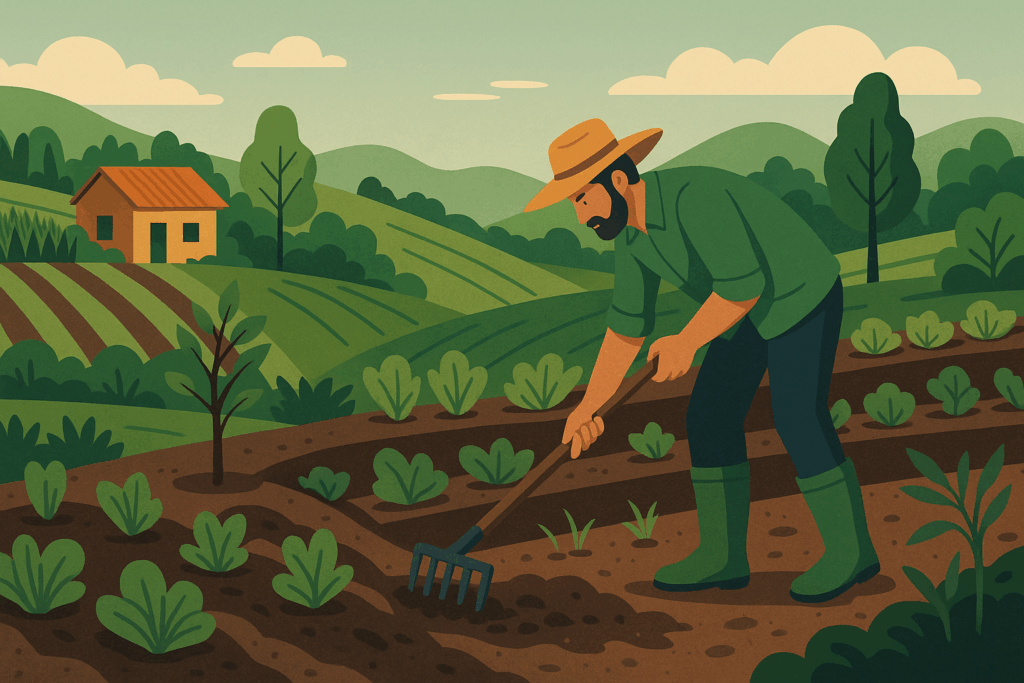
Agroecology in Practice: How Small Farmers Can Regenerate Soil and Increase Income
Agroecology is emerging as an innovative paradigm for small farmers, enabling soil regeneration and the achievement of sustainable income. Practices such as crop rotation, composting, and green manure are fundamental within this context, as they promote soil health and improve the economic viability of agricultural activities.
Crop Rotation
Crop rotation is a technique that involves alternating plant species in the same area over successive harvests. This practice contributes to soil fertility by diversifying root systems and the nutritional demands of plants. The study by Vieira et al. indicates that proper rotation can maintain and even increase phosphorus levels in the soil, which is essential for the productivity of crops such as soybeans and corn (Vieira et al., 2015). Moreover, Silva and Silva emphasize that rotation, by increasing microbial biomass and organic matter, enhances soil structure and quality (Silva & Silva, 2024). Silva et al. also affirm that this practice reduces dependency on chemical inputs, supporting more sustainable agriculture (Silva et al., 2022).
Composting
Composting, in turn, is a technique that transforms organic waste into fertilizer, promoting nutrient cycling and the recovery of soil fertility. This practice is crucial for agroecology because it allows small farmers to utilize materials available on their properties, reducing costs and increasing self-sufficiency. The use of organic matter derived from composting not only improves soil fertility but also enhances its water retention capacity (Silva et al., 2022). Therefore, composting reduces dependency on chemical fertilizers while contributing to the climate resilience of crops.
Green Manure
Green manure, another important agroecological practice, involves cultivating specific plants that are later incorporated into the soil. This improves soil structure and enriches available nutrients. According to Sbaraini et al., legumes used as green manure play a significant role in nitrogen fixation and improving soil quality (Sbaraini et al., 2022). Additionally, leaving plant residues as ground cover helps prevent erosion and increases moisture retention, which is essential in drier regions (Costa et al., 2015). Research by Kunz et al. reinforces that adopting cover crops can improve the biochemical properties of the soil, positively impacting subsequent crops (Kunz et al., 2023).
Economic Benefits
Strengthening agroecological practices not only improves soil health but also yields economic benefits. Studies such as that of Fortini et al. demonstrate that farmers who implement these conservation practices achieve greater productivity and profit (Fortini et al., 2020). This is due to reduced input costs and the higher market value of sustainably grown products, which are increasingly appreciated by consumers. In summary, the conscious and integrated adoption of techniques such as crop rotation, composting, and green manure can transform the economic and environmental reality of small farmers, promoting more sustainable and financially viable agriculture.
Conclusion
Agroecology is an approach that can not only regenerate soils but also increase the income of small farmers. By implementing practices such as crop rotation, composting, and green manure, smallholders can improve soil quality, boost productivity, and consequently, enhance their profitability.
References
- Costa, N., Andreotti, M., Ulian, N., Costa, B., Pariz, C., & Filho, M. (2015). Accumulation of nutrients and decomposition time of forage species residues as a function of sowing seasons. Bioscience Journal, 31(3), 818-829. https://doi.org/10.14393/bj-v31n3a2015-22434
- Fortini, R., Braga, M., & Freitas, C. (2020). Impact of conservation agricultural practices on land productivity and profitability of Brazilian farms. Revista De Economia E Sociologia Rural, 58(2). https://doi.org/10.1590/1806-9479.2020.199479
- Kunz, D., Rosa, C., Steffler, A., Back, P., Grellman, D., Senh, T., … & Guerra, D. (2023). Agronomic performance of black oats sown broadcast and in rows. Investigación Agraria, 25(2), 88-92. https://doi.org/10.18004/investig.agrar.2023.diciembre.2502782
- Sbaraini, Á., Corrêia, A., & Rosset, J. (2022). Participatory quality index (PQI) of no-till systems in rural properties of two municipalities in western Paraná. Desenvolvimento E Meio Ambiente, 60. https://doi.org/10.5380/dma.v60i0.75741
- Silva, I. & Silva, M. (2024). Cultivating sustainability: challenges and perspectives in organic-biological agriculture, 60-70. https://doi.org/10.37885/240115525
- Silva, M., Nascente, A., Lanna, A., Rezende, C., Cruz, D., Frasca, L., … & Filippi, M. (2022). No-till system and crop rotation in the Cerrado. Research Society and Development, 11(13), e376111335568. https://doi.org/10.33448/rsd-v11i13.35568
- Vieira, R., Fontoura, S., Bayer, C., Moraes, R., & Carniel, E. (2015). Phosphate fertilization for high productivity of soybean, corn, and winter cereals grown in rotation in Oxisols under no-till in southern Paraná. Revista Brasileira De Ciência Do Solo, 39(3), 794-808. https://doi.org/10.1590/01000683rbcs20140463
© 2025 Raízes do Bem – All rights reserved.
